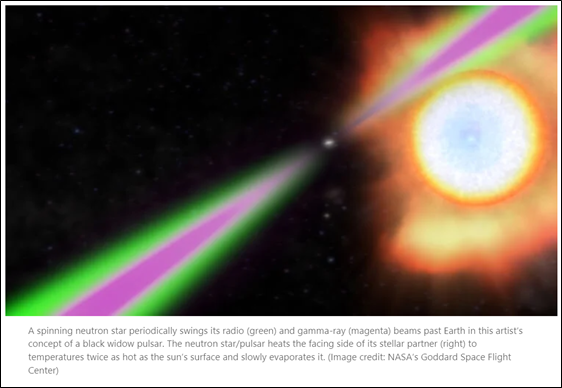

Context
For the first time, astronomers have discovered the heaviest known neutron star, an object that forms when the core of a massive star undergoes gravitational collapse at the end of its life.
- The neutron star classified as a “black widow” has a mass about 2.35 times greater than that of our sun.
About
About “Black Widow”:
- The neutron star is wildly spinning at 707 times per second.
- It has been observed the most massive known example of an object called a neutron star.
- This neutron star inhabits what is called a binary system, in an orbit with another star.
- The neutron star is a kind dubbed a "black widow," named in honor of female black widow spiders that eat their male partners after mating.
- It apparently was born with the usual mass of a neutron star, about 1.4 times that of our sun, but its gravitational pull poached material from its companion star, enabling it to grow to a mass seemingly at the uppermost limit before physics would dictate a collapse into a black hole, the densest of all known objects.
- It has swallowed nearly a full sun's worth of mass without yet becoming a black hole. So it should be just on the edge of black hole collapse.

|
About Stars
|
Neutron Stars
- Neutron stars are formed when a massive star runs out of fuel and collapses.
- The very central region of the star, the core, collapses, crushing together every proton and electron into a neutron.
- If the core of the collapsing star is between about 1 and 3 solar masses, these newly-created neutrons can stop the collapse, leaving behind a neutron star.
- Stars with higher masses will continue to collapse into stellar-mass black holes.
- Many neutron stars are likely undetectable because they simply do not emit enough radiation.
Black Hole
- A black hole is a region of space-time, where gravity is extremely strong that no object can escape from it.
- Types: There are two types of black holes which become three with the discovery:
- Stellar-mass black holes: These are the black holes with a mass of fewer than 100 times that of the Sun.
- Supermassive black holes (SMBH): These are the ones with a mass greater than 100,000 times that of the Sun.
- Intermediate-mass black holes (IMBHs): These are a class of black holes with a mass approximately 100 to 100,000 times that of the Sun.
- Both stellar black holes and SMBHs are commonly found.



